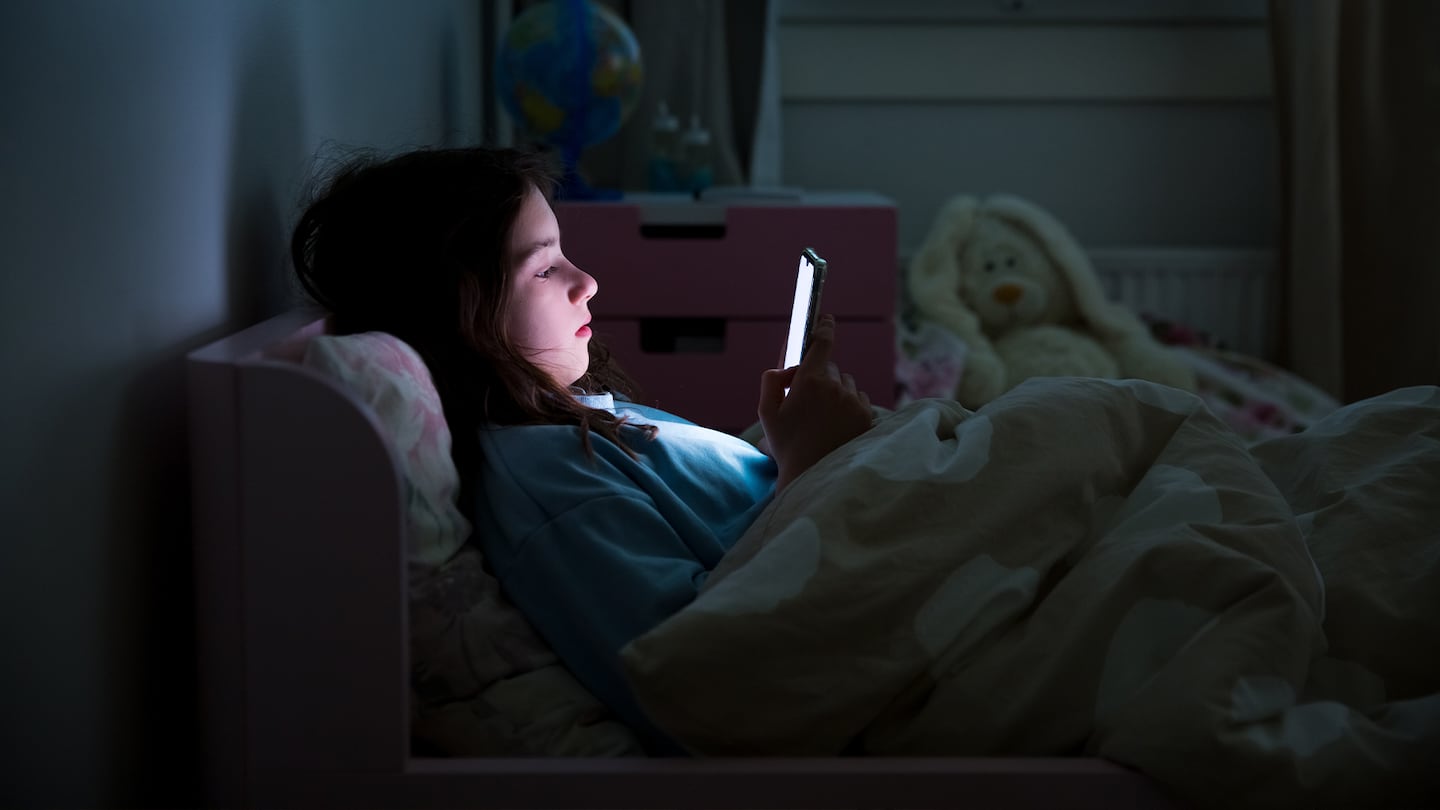
The Business of Fashion
Agenda-setting intelligence, analysis and advice for the global fashion community.

Agenda-setting intelligence, analysis and advice for the global fashion community.

Fashion’s and beauty’s favourite marketing channel is facing a backlash as concerns grow that social media is harming kids’ mental health.
Social media’s psychological effects on children have been the subject of mounting scrutiny in recent weeks. Jonathan Haidt, a social psychologist at New York University, has provoked impassioned debates with his argument that the technology has disrupted childhood development and led to a surge in problems such as depression, anxiety and suicide. The view provides the basis for his new book, “The Anxious Generation: How the Great Rewiring of Childhood is Causing an Epidemic of Mental Illness.”
On March 25, the day before the book’s publication, Florida’s Republican governor, Ron DeSantis, signed a bill that’s set to bar many children in the state from having social-media accounts at all, one of the strongest sets of social-media restrictions passed in the US to date.
Lawmakers, researchers, parents and others have for years worried that social media isn’t just gobbling up inordinate amounts of kids’ time and attention but is also genuinely bad for them. As they scroll through the addictive, infinite feed of videos and images, they’re seeing a distorted view of reality, training their brains for distraction and foregoing the necessary neurological nourishment that comes from real-world interaction.
ADVERTISEMENT
The science behind these fears is far from conclusive, however. Just as uncertain is what impact the debate, and laws like Florida’s, will have on social media and its users.
Brands may not think about the matter much, but they’re part of the content stream that keeps kids hooked, raising questions about how they should respond. It’s not hard to envision them being swept up in the discourse due to their substantial presence — and marketing — on social platforms.
Research into social media’s impact on mental health has been ongoing for years, but it’s hard to isolate its influence from all the other forces simultaneously affecting kids. Still, some, like Haidt, have concluded it’s responsible for the clear decline that’s taken place.
“My claim is that the new phone-based childhood that took shape roughly 12 years ago is making young people sick and blocking their progress to flourishing in adulthood,” Haidt wrote in an adapted excerpt of his book that appeared in The Atlantic in March. “We need a dramatic cultural correction, and we need it now.”
He points to a rise in issues such as depression, anxiety and suicide that began in the early 2010s, right around the time smartphones started becoming ubiquitous across wealthy countries. In the US in particular, loneliness increased, while test scores in reading and maths declined. Gen-Z, the first generation to come of age with smartphones, dates less and has less sex than previous groups, and tends to be more risk averse as well.
Though Haidt acknowledges there are varying theories as to the cause of these trends, he believes their timing and appearance in numerous countries almost simultaneously indicate a clear inciting factor.
“Those were the years when adolescents in rich countries traded in their flip phones for smartphones and moved much more of their social lives online — particularly onto social media platforms designed for virality and addiction,” he wrote. “Once young people began carrying the entire internet in their pockets, available to them day and night, it altered their daily experiences and developmental pathways across the board.”
The trouble with this conclusion is that correlation is not causation — in other words, just because smartphones came on the scene at the same time childrens’ mental health began to deteriorate is not in itself evidence that it was the cause.
ADVERTISEMENT
Perhaps the strongest rebuttal to Haidt’s argument has come from Candice L. Odgers, a professor of psychology at the University of California Irvine and director of research at its School of Social Ecology, which tries to devise science-backed solutions for social and environmental challenges.
“Hundreds of researchers, myself included, have searched for the kind of large effects suggested by Haidt,” Odgers wrote in a review of his book for the science journal Nature. “Our efforts have produced a mix of no, small and mixed associations.”
One analysis across 72 countries found no clear link between social media’s spread and drops in well-being. In the US, a large, long-term study of brain development in adolescents similarly came up with no evidence that digital technology was prompting changes.
What the research does suggest, according to Odgers, is that young people who come to social media with preexisting mental-health problems tend to use it more frequently or differently than their peers.
More research is needed, she said, and the desire for answers is understandable. But pointing the finger without knowing the real cause or causes isn’t helpful, she noted.
In March 2023, Utah became the first state to pass legislation governing children’s social media use, with a revised version of the law set to come into force this October. Some other states have passed their own laws, with effects such as mandating platforms require age verification for children creating accounts, giving parents more control over what their children can do online or holding social media companies liable for harms, according to a report by the University of North Carolina at Chapel Hill’s Center on Technology Policy. There are also dozens of bills and resolutions currently pending, based on a running list from the National Conference of State Legislatures.
But even signed bills haven’t all moved ahead uncontested. Courts have blocked laws, at least temporarily, such as one in Arkansas last year, on the grounds they violate the free speech protections of the First Amendment.
Florida’s house speaker, Paul Renner, told The Washington Post the state’s bill deliberately avoided any mention of content to dodge the issue and aimed its restrictions at “the addictive technology,” though it’s still likely to face challenges. It bars children younger than 14 from having social media accounts and lets parents decide whether their 14 and 15-year-olds can have accounts. The law is scheduled to take effect on Jan. 1, 2025.
ADVERTISEMENT
Others, meanwhile, have called for stakeholders like technology companies and educators to take action through efforts ranging from stricter content moderation to bans on phones in schools. Last week, four school boards in Canada took matters into their own hands and sued TikTok, Meta and Snapchat, accusing them of being addictive by design.
There is a growing conversation around brands’ responsibilities toward young consumers, particularly in the beauty industry. The proliferation of dermatologists and beauty experts who tout the use of different ingredients and spotlight efficacious products on platforms like TikTok has contributed to the beauty craze among Gen-Alpha, the oldest of whom turn 13 this year.
“Skincare is what kids [my daughter’s] age talk about, even those without social media,” Kristen Miller, a New York-based dermatologist and mother of an 11-year-old girl, told BoF in January. “This information percolates and you start finding kids hanging out at Sephora even when they aren’t buying anything.”
Brands like Drunk Elephant, whose brightly coloured packaging for its creams and serums are a favourite among this group, say education should be the responsibility of parents. Others, like Peace Out Skincare, Kiehl’s and Swedish skincare label Mantle are letting their Gen-Alpha customers know their products are not age appropriate.
Last week, Mantle started requiring shoppers to declare whether they are over 18 in order to shop its face masks and serums. Kiehl’s followed suit with a social media campaign geared towards the parents of tweens. The message was direct: Kiehl’s is not for children.
The declarations may do little to dissuade young shoppers. Mantle’s age restriction is easy to bypass by merely clicking the “I am over 18″ box, and beyond the campaign, neither Kiehl’s nor its parent company, L’Oréal Group, have yet to issue formal statements about how the label will, or will not, target younger consumers moving forward.
Fashion brands haven’t been ensnared so directly in the discourse, but they aren’t exempt. Teen-centric label Brandy Melville, which is the subject of an upcoming HBO documentary, has come under fire for its inclination towards very thin, white girls in its imagery and hiring, while videos of Shein hauls online have spurred criticism that the company is promoting mindless consumerism in US teens. As fears that kids are suffering from what they see online rise among parents and politicians, brands could get caught up in the backlash.

Marc Bain is Technology Correspondent at The Business of Fashion. He is based in New York and drives BoF’s coverage of technology and innovation, from start-ups to Big Tech.

Yola Mzizi is the Editorial Apprentice at The Business of Fashion (BoF). She is based in New York and provides operational support to the New York team and writes features for BoF and The Business of Beauty.
BoF Careers provides essential sector insights for fashion's technology and e-commerce professionals this month, to help you decode fashion’s commercial and creative landscape.
The algorithms TikTok relies on for its operations are deemed core to ByteDance overall operations, which would make a sale of the app with algorithms highly unlikely.
The app, owned by TikTok parent company ByteDance, has been promising to help emerging US labels get started selling in China at the same time that TikTok stares down a ban by the US for its ties to China.
Zero10 offers digital solutions through AR mirrors, leveraged in-store and in window displays, to brands like Tommy Hilfiger and Coach. Co-founder and CEO George Yashin discusses the latest advancements in AR and how fashion companies can leverage the technology to boost consumer experiences via retail touchpoints and brand experiences.